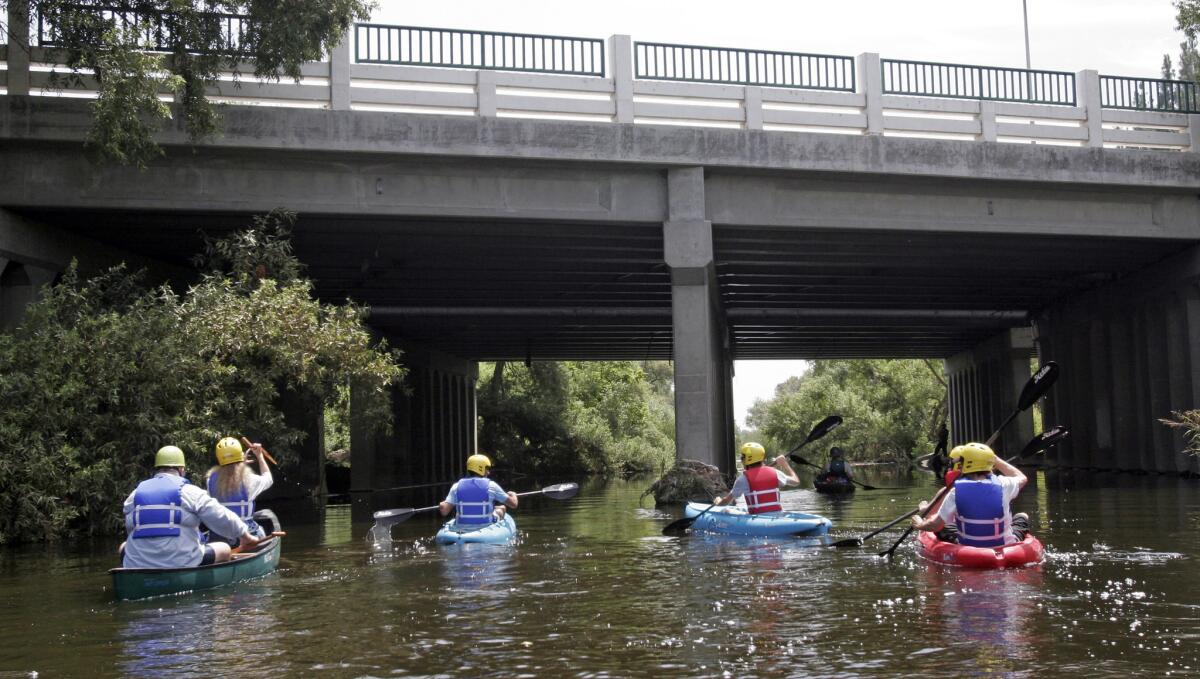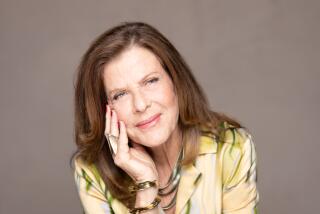Editorial: Can Frank Gehry fix the L.A. River?

Kayakers paddle down the Los Angeles River in the Sepulveda Dam recreation area in Van Nuys.
- Share via
There comes a point in “Water and Power” — Richard Montoya’s 2006 play about two brothers, conspiracy, corruption and Los Angeles — when a shadowy “Fixer” steals the soul of a young Latino state senator. That soul comes in the form of a giant concrete storm drain that has snaked its way from the San Fernando Valley to Long Beach Harbor since the 1930s but is due to be reinvented, by the senator, into a ribbon of green parkland that will provide fresh air and a bit of nature to the struggling families who live adjacent.
The Fixer has other plans. “I need condos on your L.A. River green space, Mr. Agua,” he tells the senator. “I need live-work lofts, gated communities, gringo hipsters walking little dogs, storefront galleries with crappy art, a Coffee Bean would be sa-weet! IKEA, East L.A.!”
And there you have it. The playwright saw this coming more than a decade ago — the struggle over the Los Angeles River.
Planning the river’s future was long the province of just a few people, chiefly poet Lewis MacAdams and the organization he founded and leads, Friends of the Los Angeles River. Then it became a democratic community project, spearheaded by then-City Councilman Ed Reyes and discussed and designed by artists and activists in a series of neighborhood workshops and design charrettes aimed at creating a 20-year master plan.
And then, by this time last year, it had become a real estate project, as speculators saw the prospect of a second Los Angeles waterfront and The Times reported on skyrocketing asking prices for parcels with views of what for now is still a storm drain.
The Los Angeles River was shunned by nearly everyone until the daydream of remaking it into a river moved toward reality. Now everyone wants a piece of the action. It is the city’s ultimate contested space. That became clearer than ever last month, when The Times reported that architect Frank Gehry had been working busily for a year on a plan for the river.
How did Gehry get in on the act? He was invited — by the L.A. River Revitalization Corp., a nonprofit created by the city to manage river policy.
In the eyes of some river supporters, Gehry’s involvement smacked of power plays and sellouts. A democratic process in which the community had been invited to participate appeared to have been subverted by shadowy fixers, and if that were really the case, Gehry’s involvement would indeed be a step in the wrong direction.
But in fact it’s not clear that there has been any subversion; Gehry’s plans haven’t been seen yet, much less approved. But Gehry is bringing something important that until now had been given little more than lip service. He is working with a team of hydrologists to find ways to recapture storm runoff for reuse.
It has long been the position of this page that a multibillion-dollar project to reclaim the river, to remove much of its concrete, to create a wildlife corridor and to open up park space for neighborhoods must also — if it is to be worth the investment — change the city’s relationship with its water.
The concrete was placed there to avoid flooding and get runoff to the sea as quickly as possible. When it is removed, it must be done at least in part to slow down that rush, direct water into the ground, recharge aquifers, reduce rainy season pollution of the bay and the beaches, and allow Los Angeles to rely at least slightly less on water imported from distant parts of the state at great monetary and environmental cost.
Gehry brings something else as well: his name. Angelenos are wary of authority and suspicious of grand plans secretly hatched, but they also live in a city of red carpets and velvet ropes, private clubs and superstars — and let’s face it, a little Gehry panache couldn’t hurt the fundraising effort it will take to supplement whatever funds the federal government puts into the river project with enough additional money to get the job done. The superstar architect’s participation need not undermine the activist vision and community input that has brought the river’s reinvention to the brink of reality.
The Fixer, in Montoya’s play, asserts that “nothing is concrete in L.A., except the river.” Perhaps. But Gehry may be able to help even the river to become a little less concrete.
Follow the Opinion section on Twitter @latimesopinion and Facebook
More to Read
A cure for the common opinion
Get thought-provoking perspectives with our weekly newsletter.
You may occasionally receive promotional content from the Los Angeles Times.










